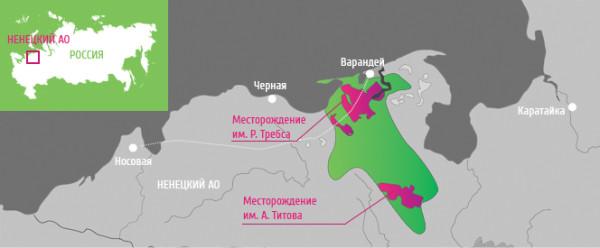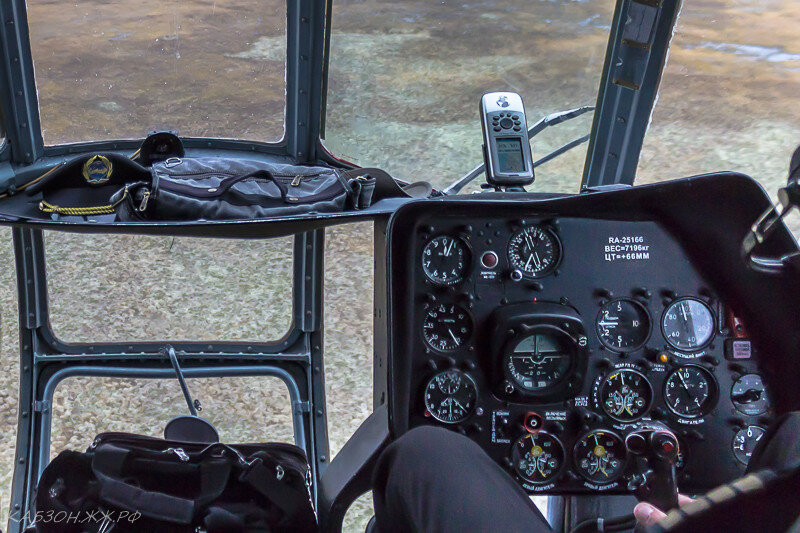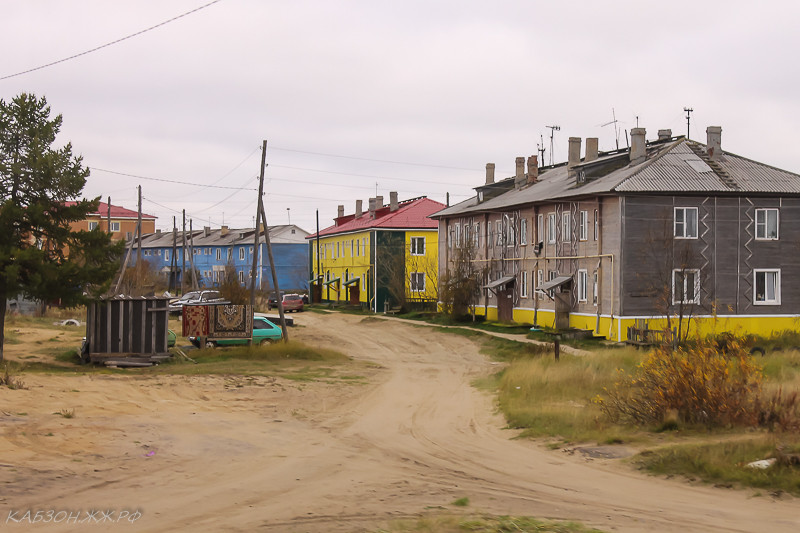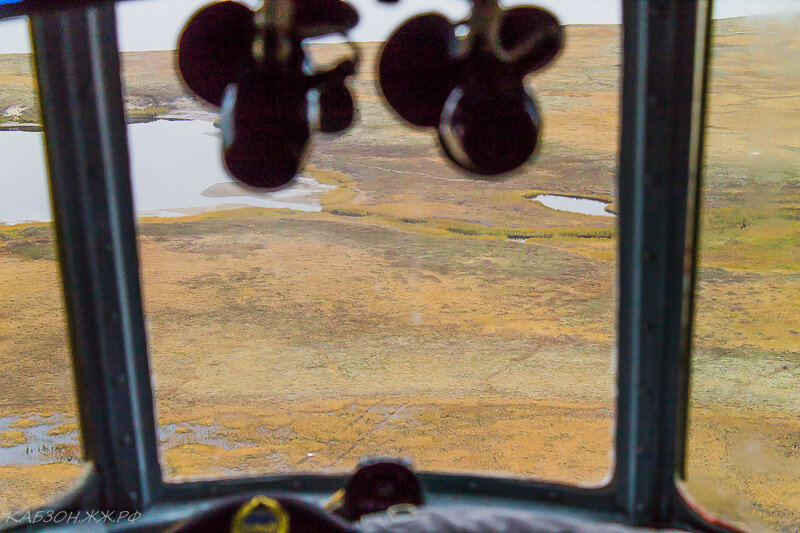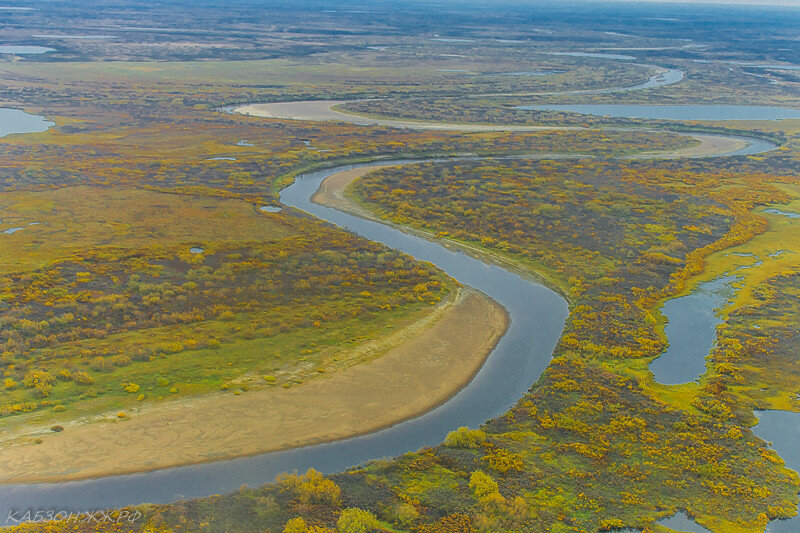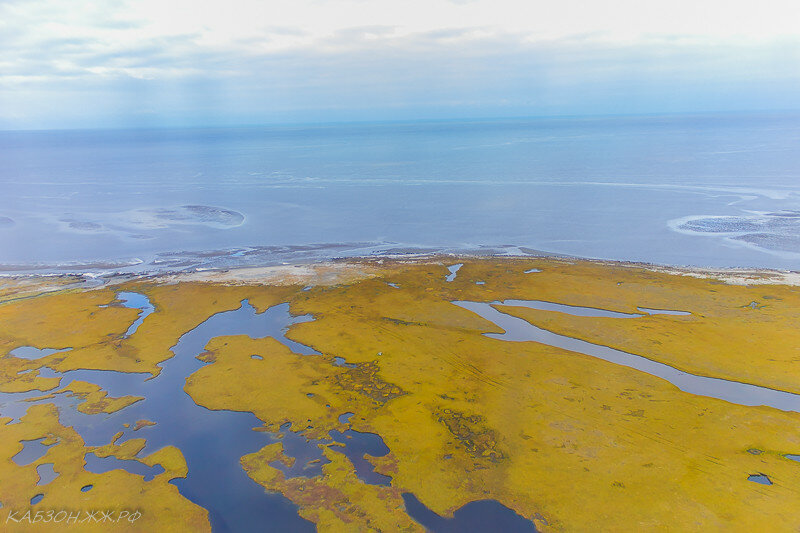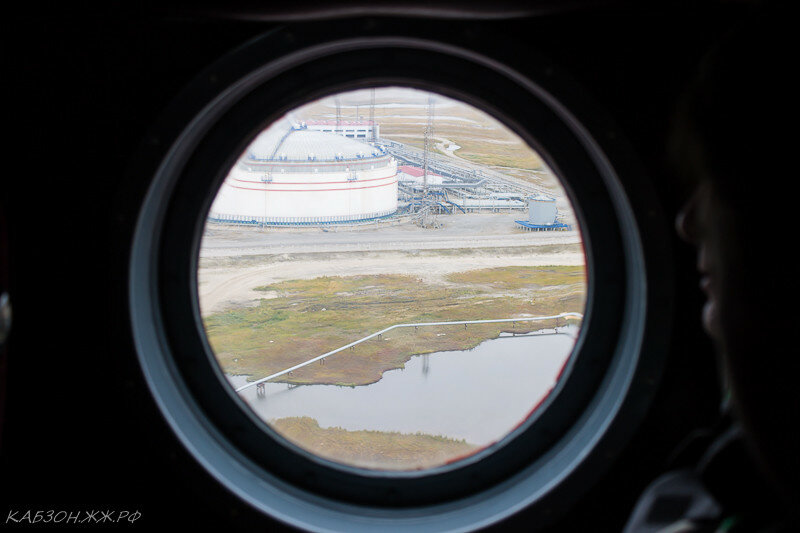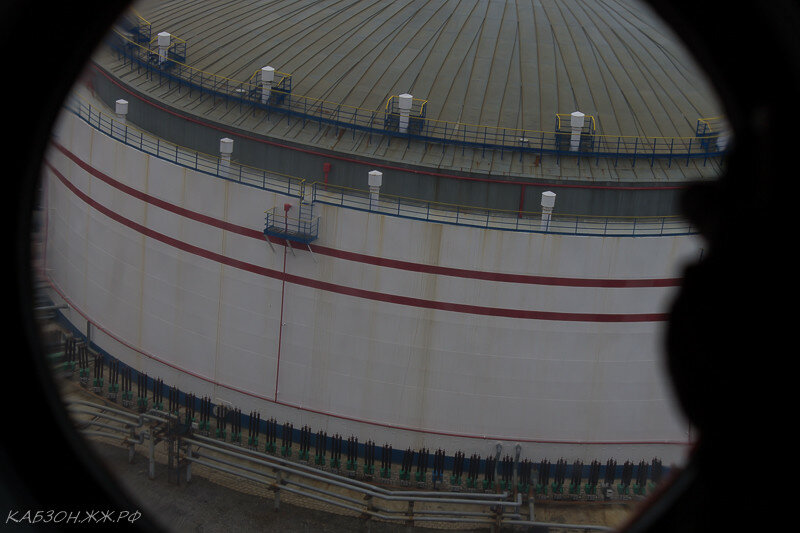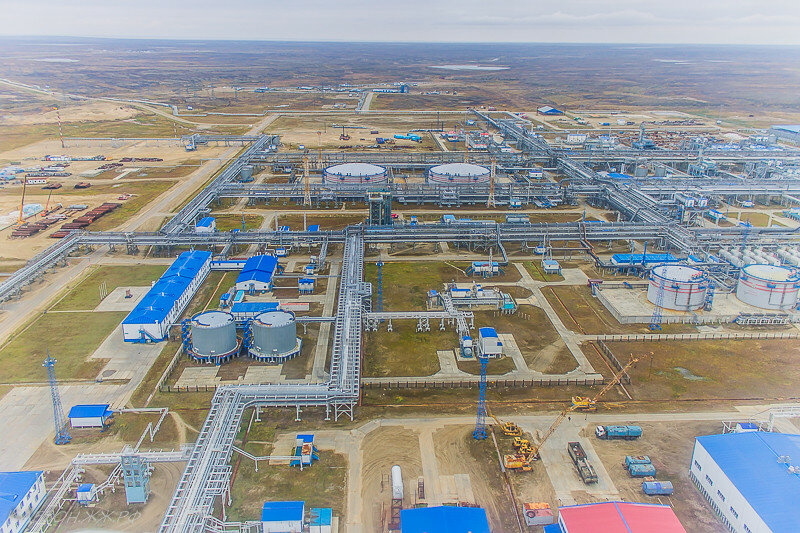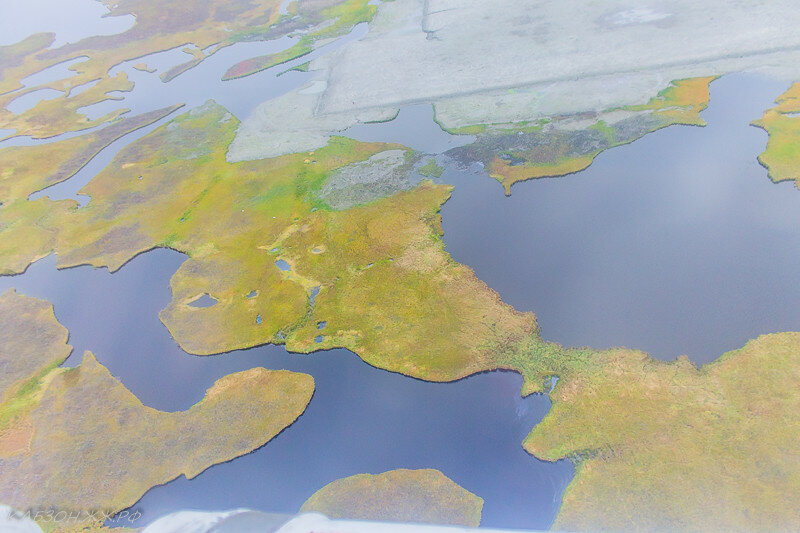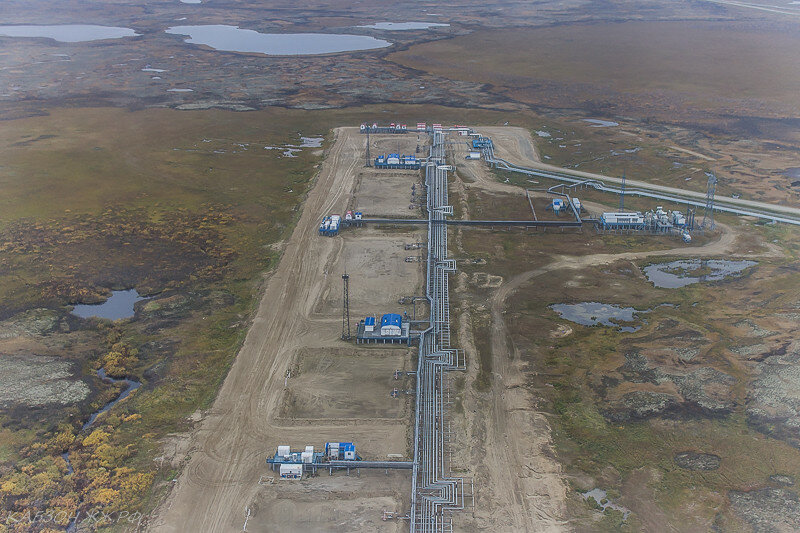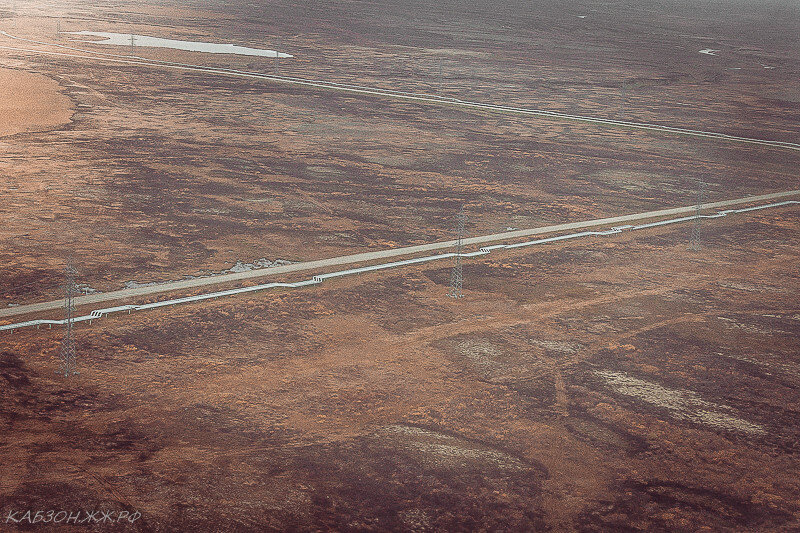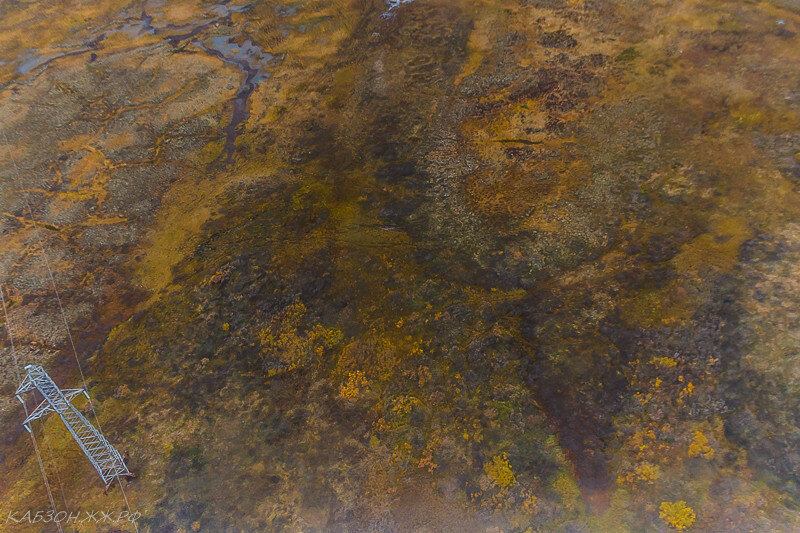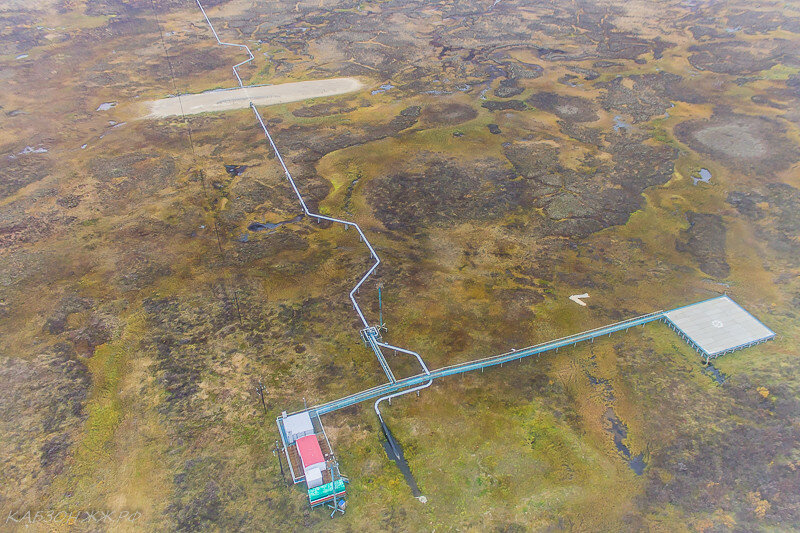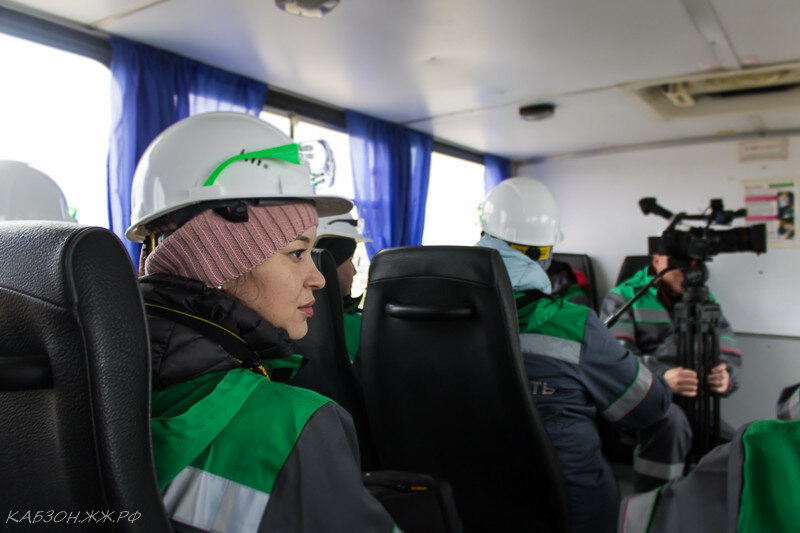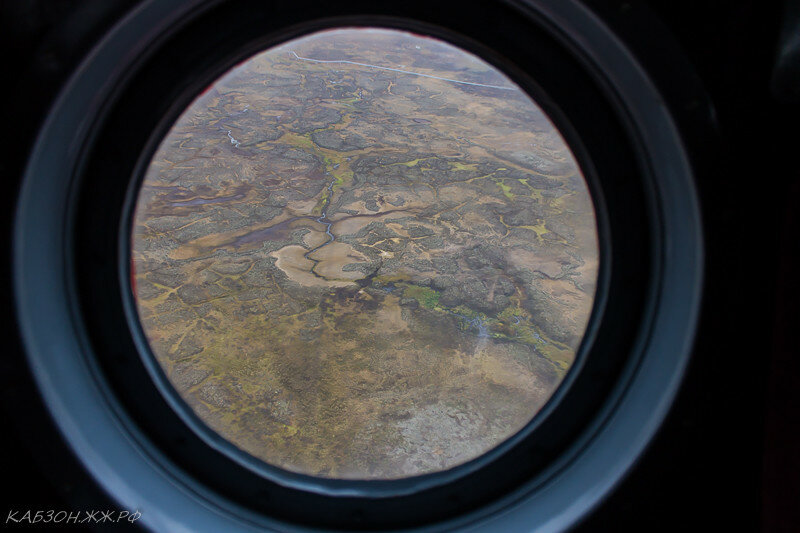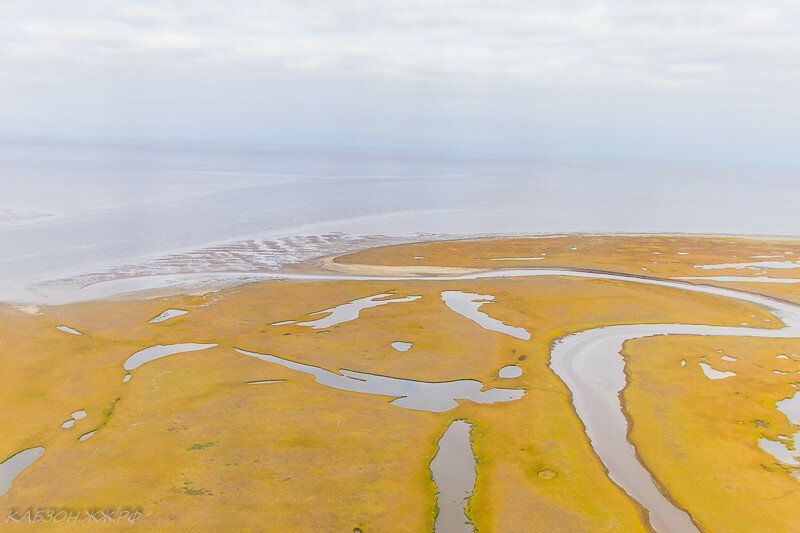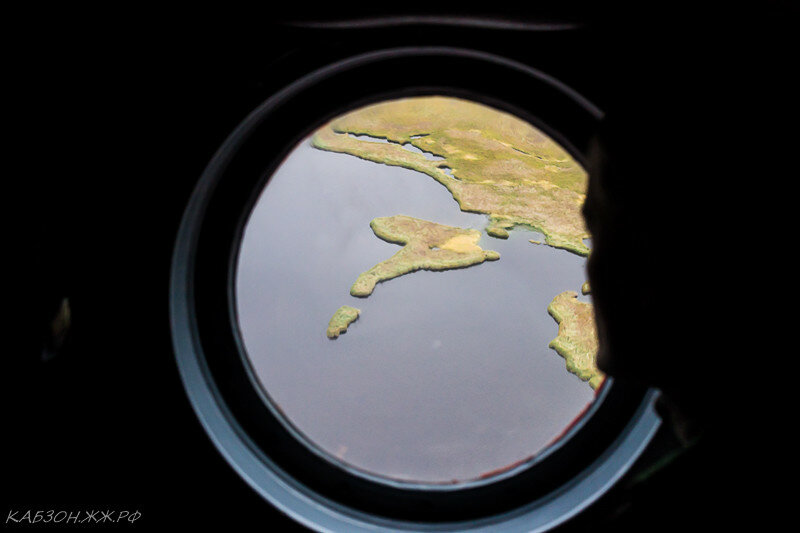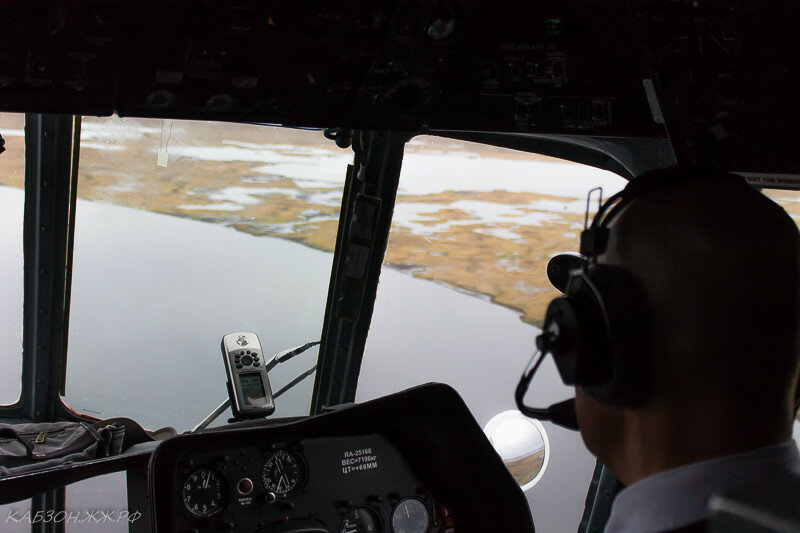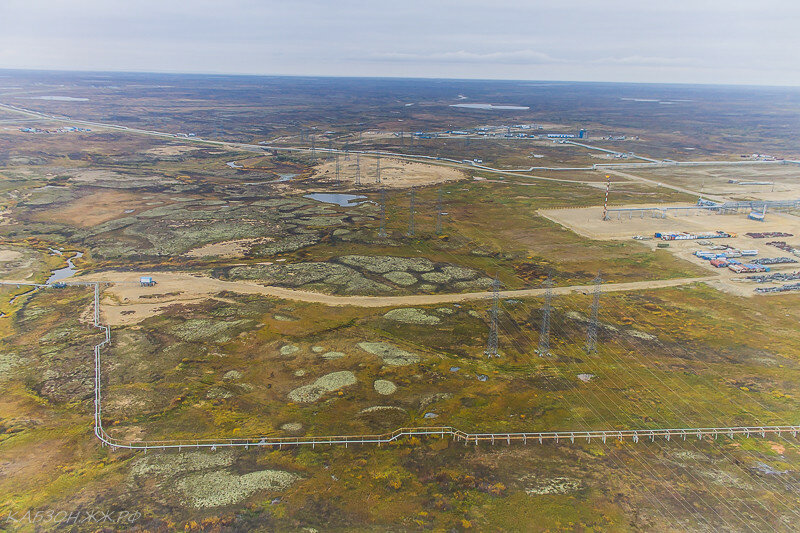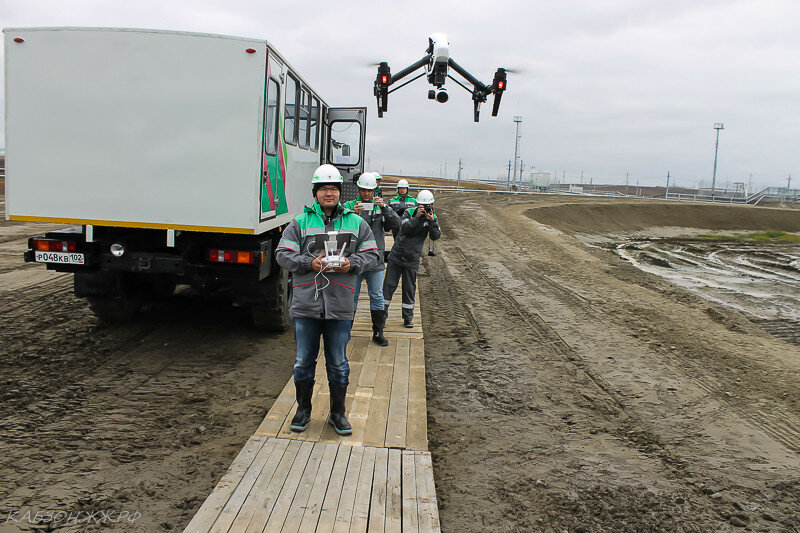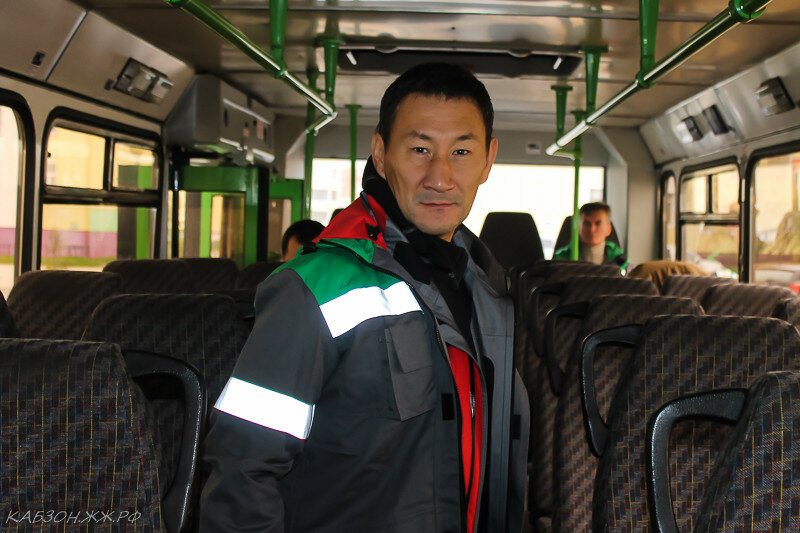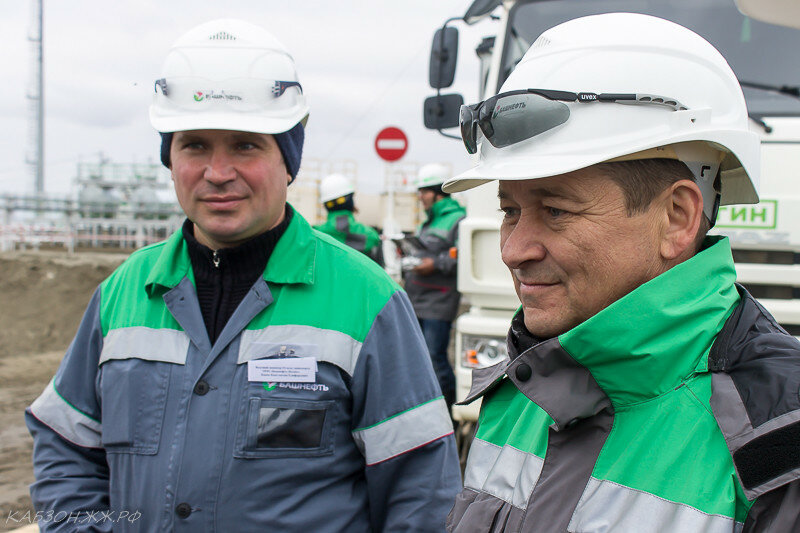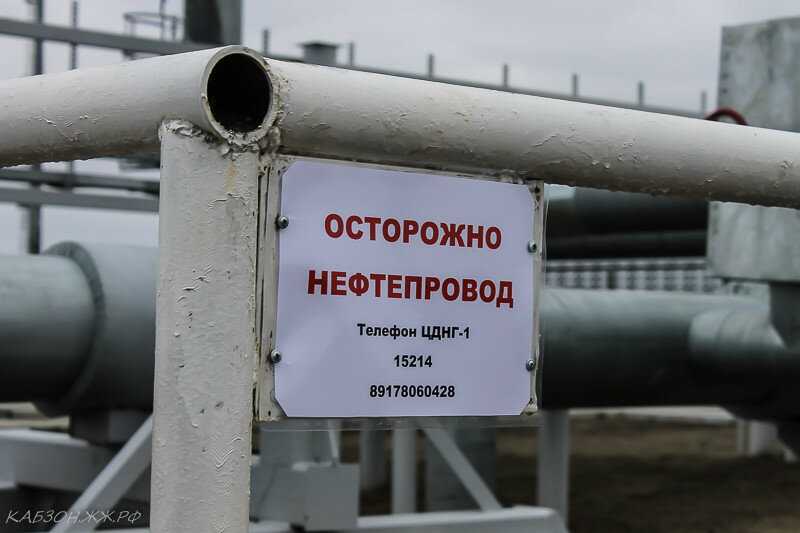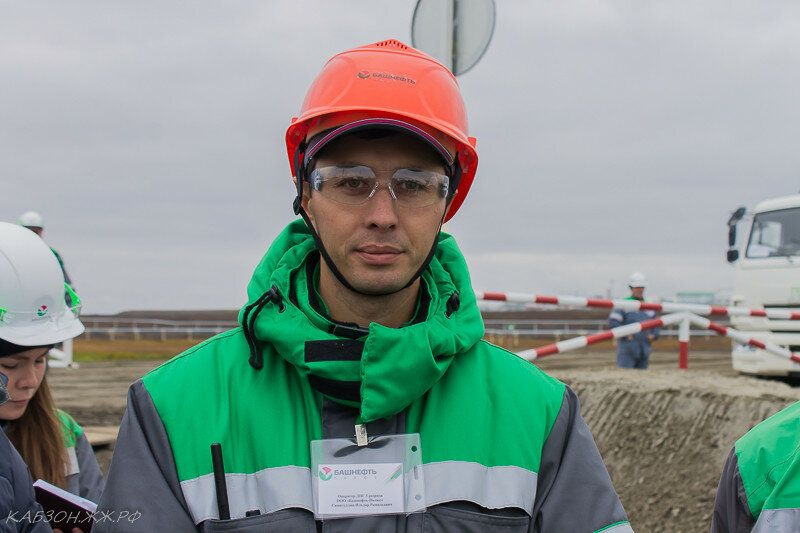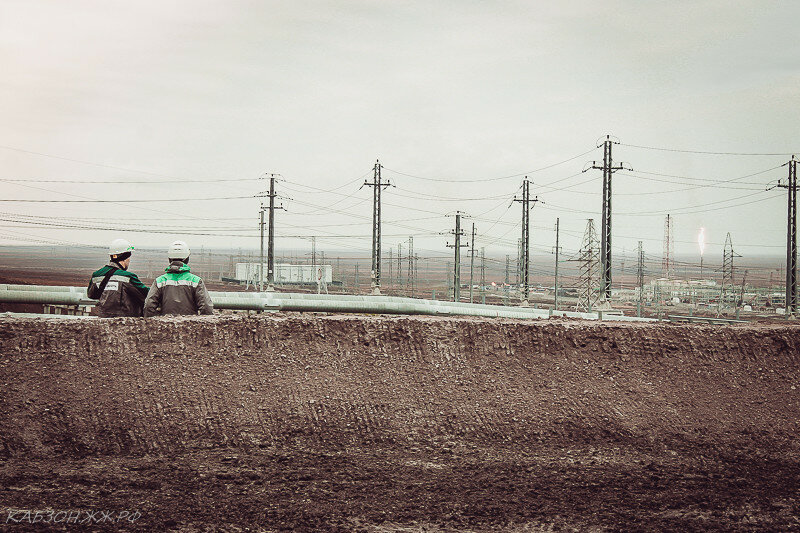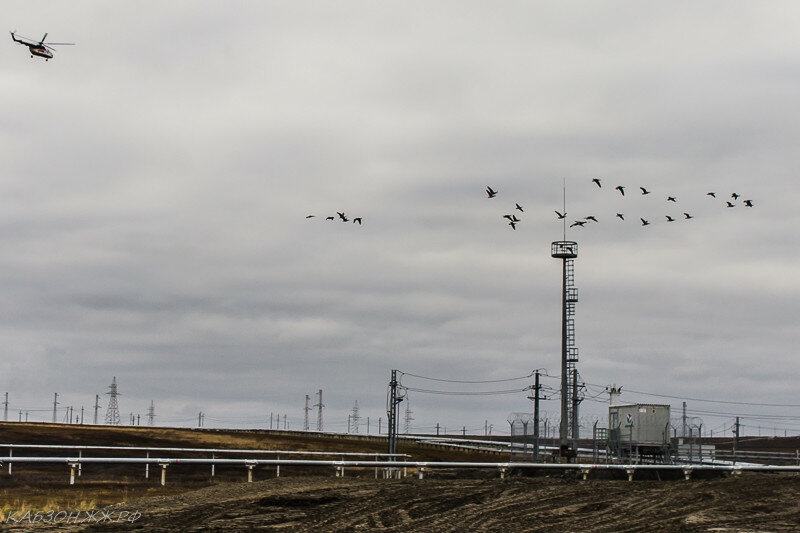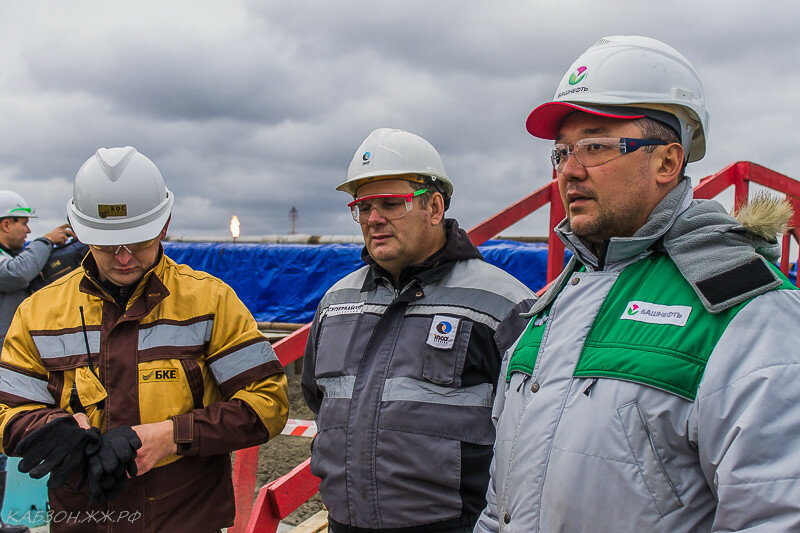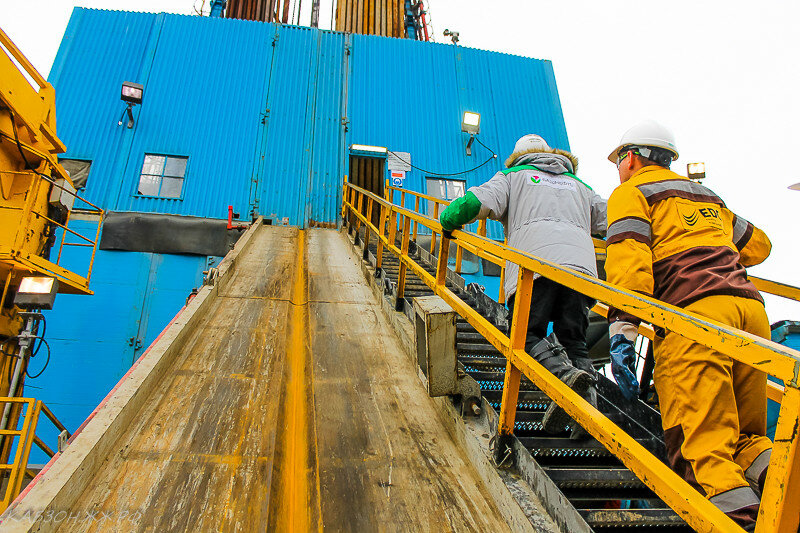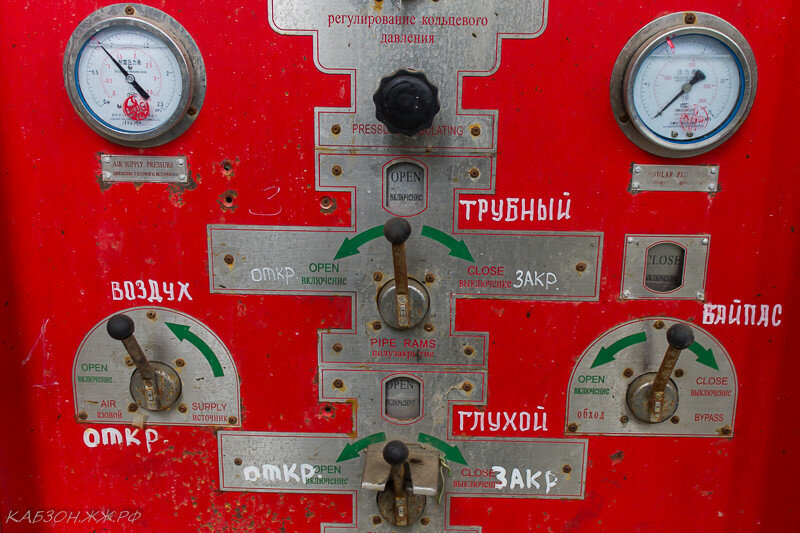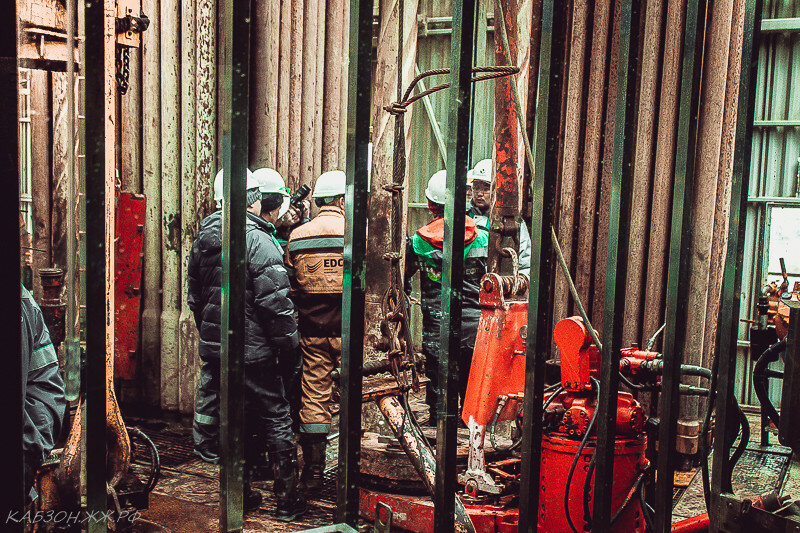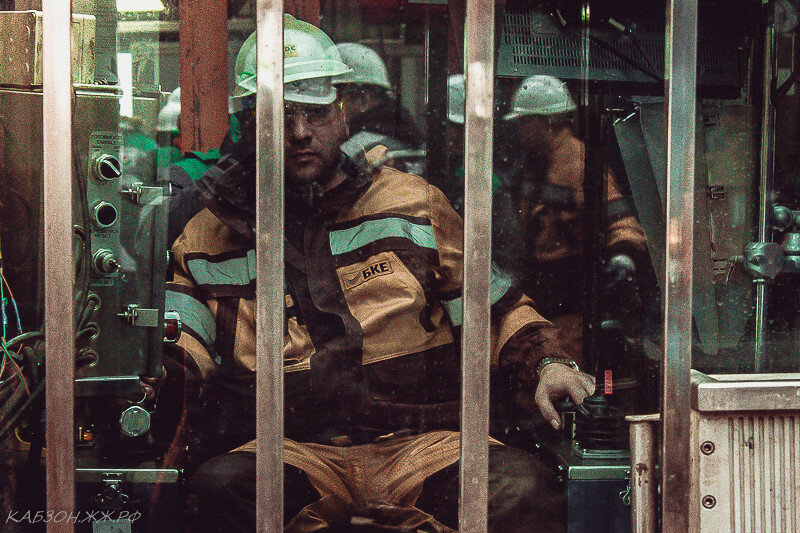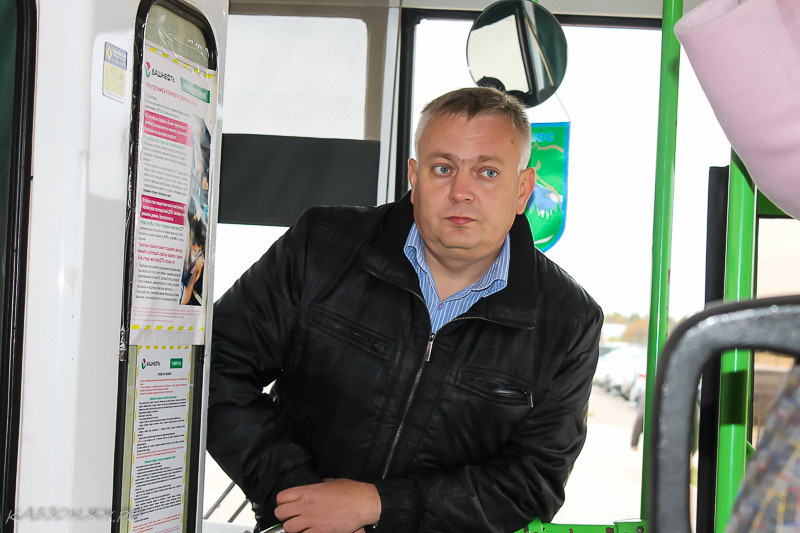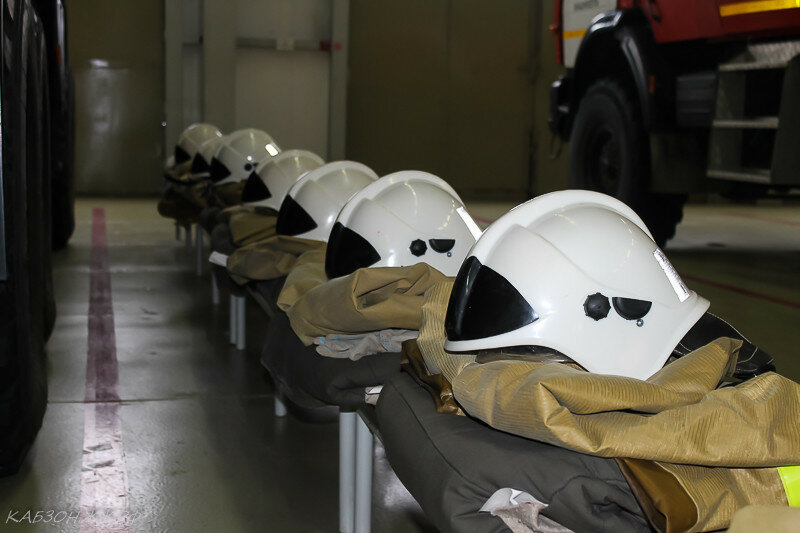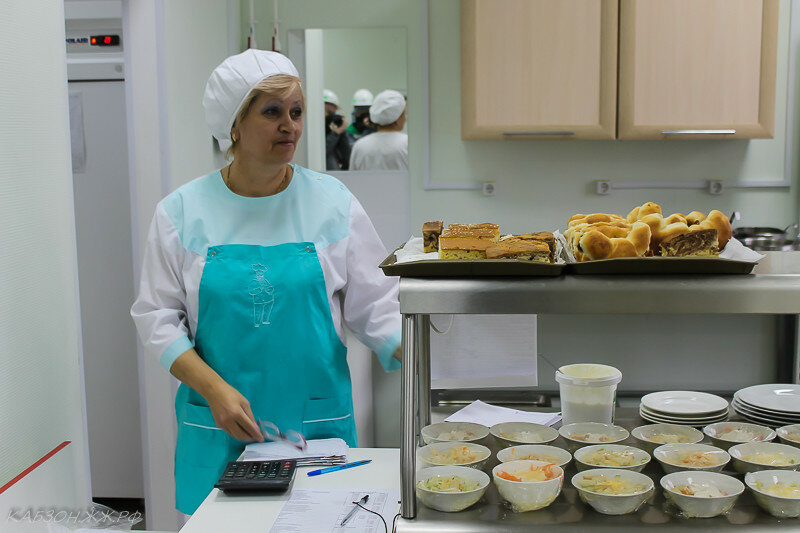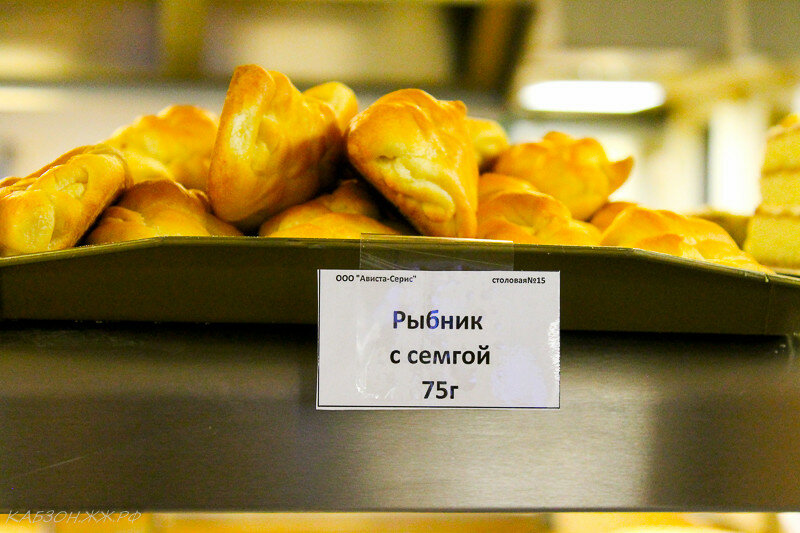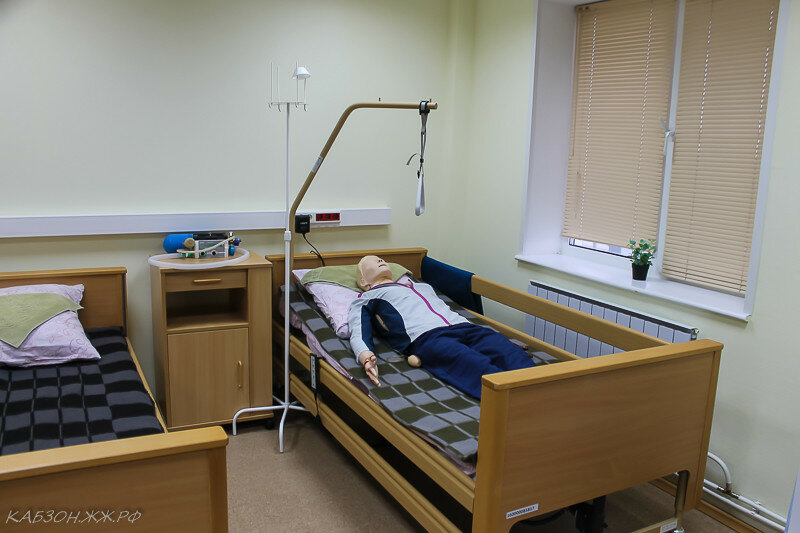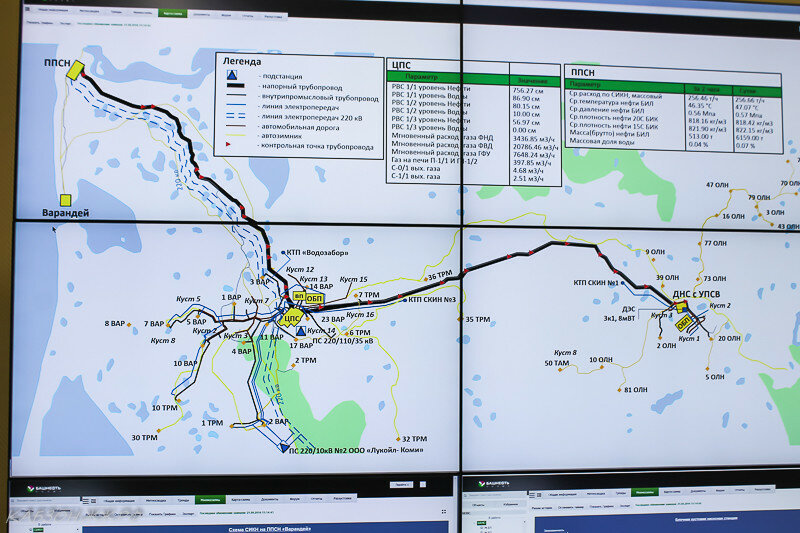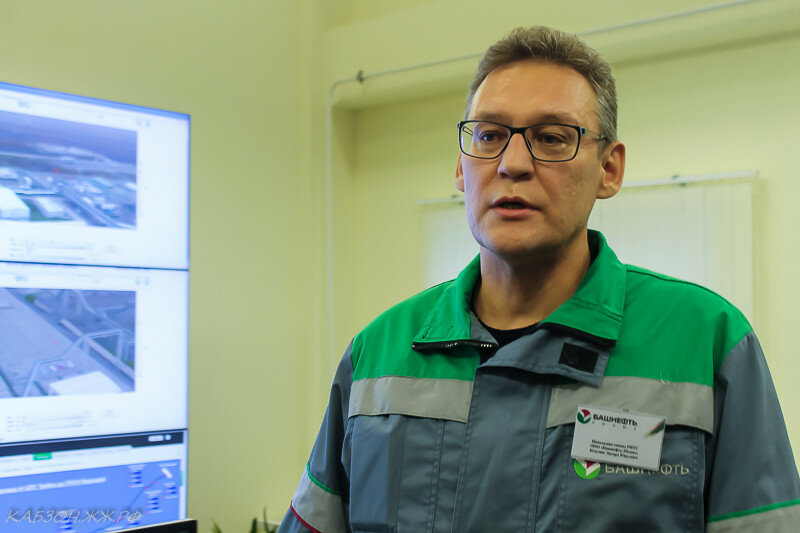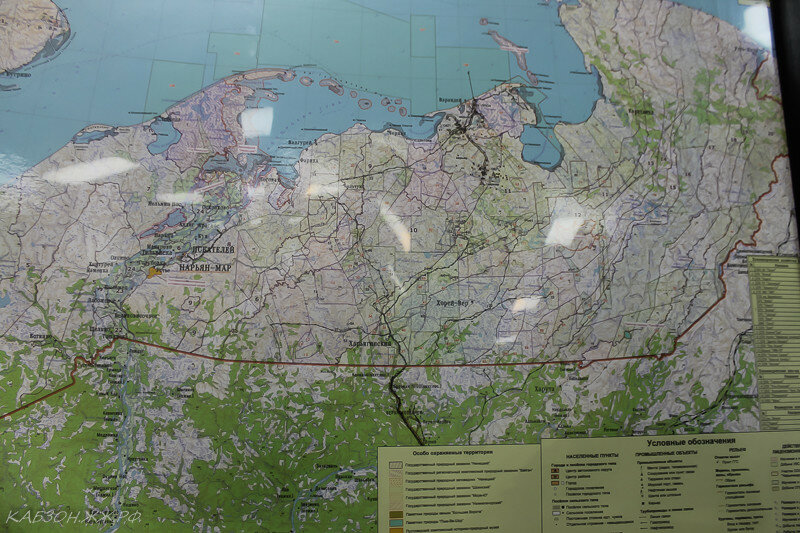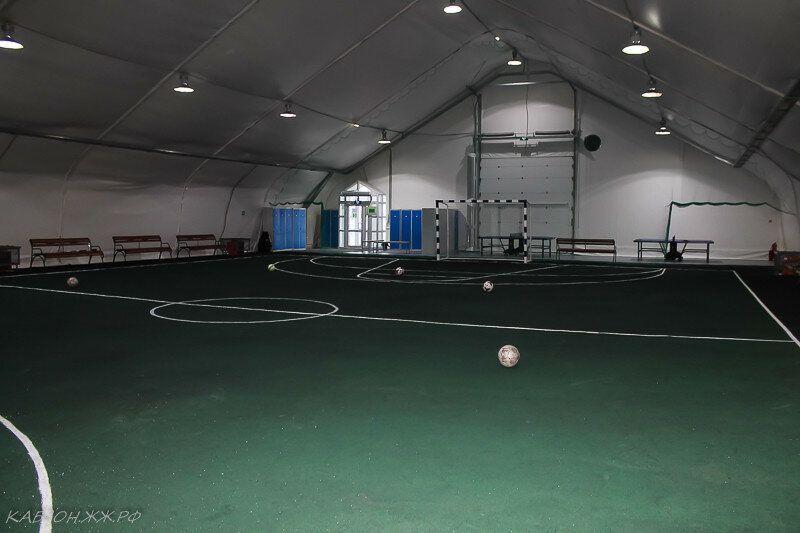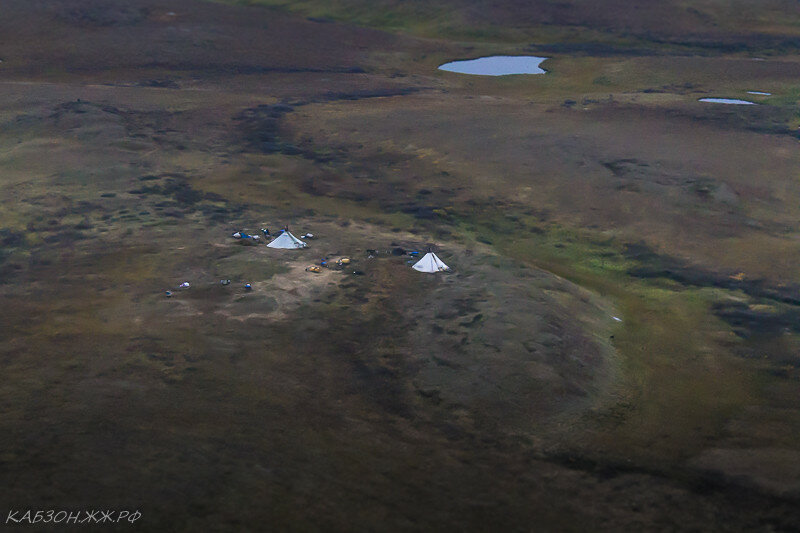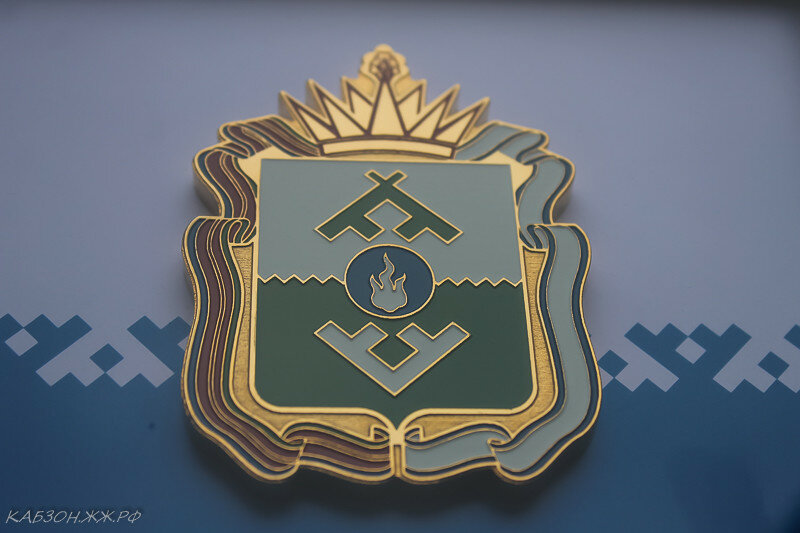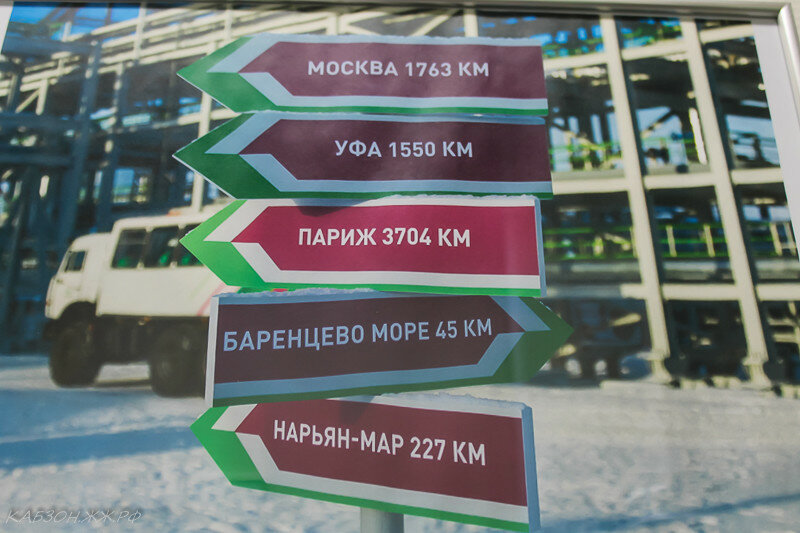Месторождения Требса и Титова. Месторождение на карте титоваМесторождения Требса и Титова. Двухдневное путешествие журналистов и блогеров на край земли. Анонс.: kabzonЕсли вы хотите узнать цифры, объемы добычи и дебеты скважин, то вам наверное интереснее будет почитать технические журналы, благо их написано много и про крупнейщее месторождение России они пишут много и с удовольствием.Я же попробую вам рассказать, а скорее даже не рассказать, а показать в картинках как живут там люди, как работают механизмы и как выглядит этот суровый клочек земли на берегу .Для начала немного ликбеза. Оказывается месторождений два. Первое Требса, второе месторождение имени Титова,
Город Нарьян-Мар. Аэропорт.
  Ах да... Про Нарьян-Мар Небольшой городок с населением 24 тысячи человек. (на ненецком языке "Няръяна мард" - Красный город)Площадь Нарьян-Мара 4512,8 га . 
Город Нарьян-Мар находится за полярным кругом, расположен в низовьях реки Печоры.
В 110 км от Баренцева моря.
Расстояние от Москвы до Нарьян-Мара – 1500 км. Ближайшая железнодорожная станция - Усинск – находится на расстоянии 420 км, добраться до неё по суше можно только по зимней автомобильной дороге (зимнику). В период навигации на Печоре действует паромная переправа Шельяюр – Нарьян-Мар. Я обязательно сделаю отдельный репортаж и расскажу про этот замечательный город.Про его историю, флору, фауну и быт коренных жителей.
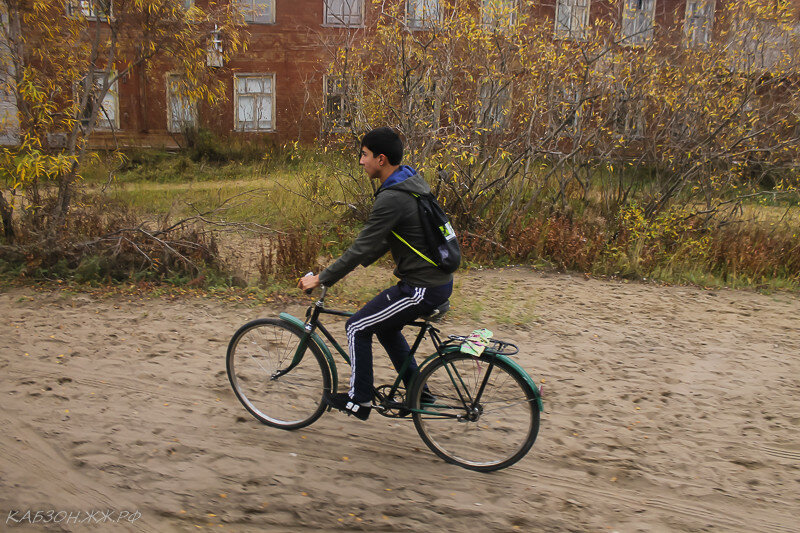 А пока давайте сядем в вертолет и полетим на самый край земли... 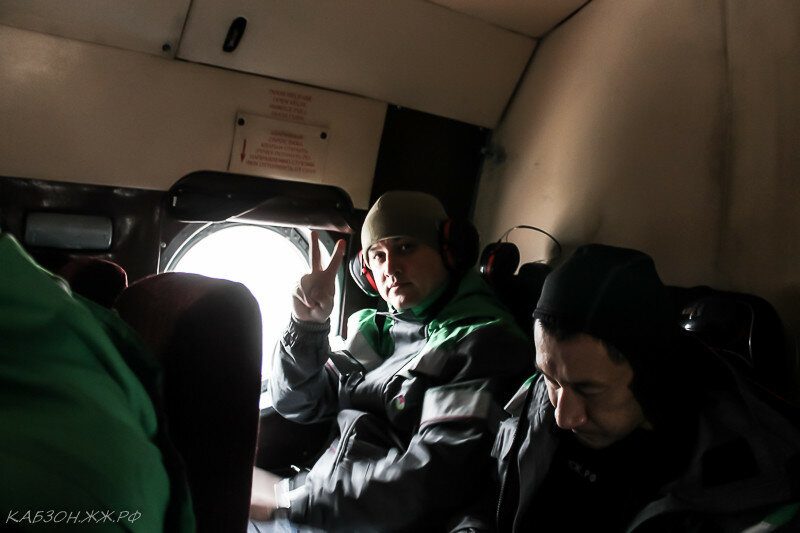
Южный берег Печорского моря. Варандей.
В 15 км от месторождения Требса находится вахтовый посёлок Варандей с морским портом для приёма крупных морских судов и терминалом для загрузки танкеров. Посёлок используется для отгрузки нефти с ближайших месторождений — Варандейского и Торавейского, к которым проложены нефтепроводы.
И вот наконец мы подлетаем к месторождению Титова...
Мы это: Команда Башкирского Спутникового Телевидения БСТ с камерами, штативами и квадрокоптерами
Мы это фотографы, блогеры и журналисты
Мы- это корреспонденты Нарьян-марского телевидения
Мы- это разношерстная компания с разных городов России. Невозможно в одном репортаже рассказать про наше путешествие.Чуть позже. я расскажу вам много интересного и любопытного про этот удивительный край.А сейчас просто сделаю анонс: Часть первая. Мы с вами побываем на Месторождении Требса и поглядим как там живут люди. Чем питаются. как проводят свой досуг.Обзорная экскурсия по месторождению, пройдет с самыми лучшими проводниками.Людьми которые там живут и работают.
Во второй части, мы побываем на буровой установке:
Я расскажу вам как бурят породу и покажу как это выглядит глазами фотографа.
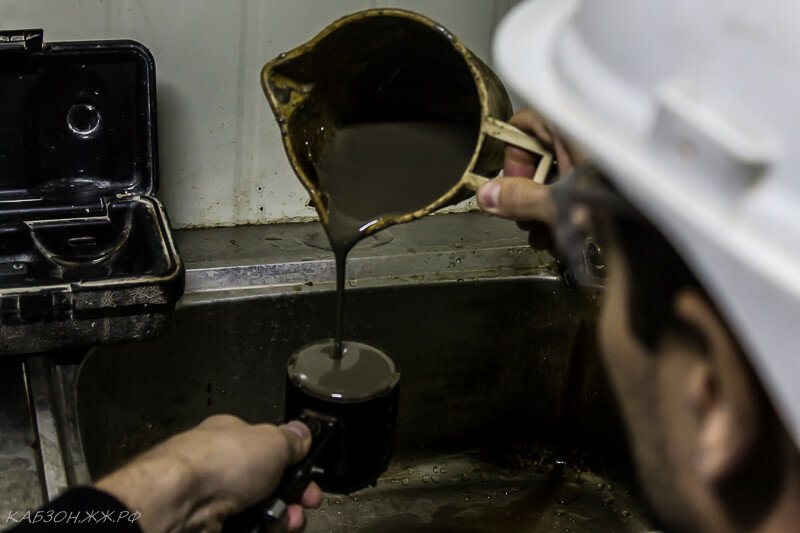
Третьим пунктом нашей экскурсии будет ознакомительная поездка по Нарьян-Мару
и встреча с губернатором. 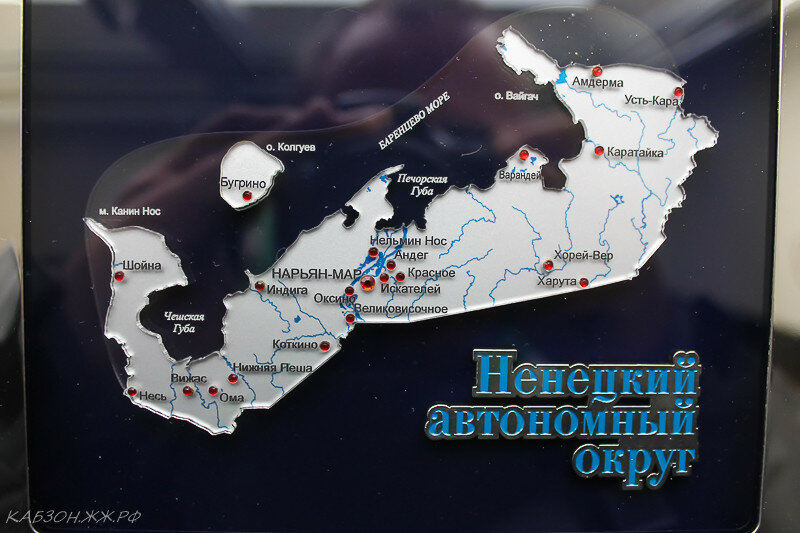 Мы посетим пожарных
побываем в столовой И в медпункте Побываем даже в святая-святых. На пульте управления месторождением ТиТ
Побываем в музее Ознакомимся с бытом вахтовиков и даже поглядим на жизнь народов Крайнего Севера с высоты птичего полета.
Не переключайтесь. Будет интересно.
Повторяю. Будет очень, очень интересно. kabzon.livejournal.com Требса и Титова (Месторождение им Р. Требса и А. Титова) | МесторожденияМесторождение им Р. Требса (Варкнавтское месторождение) и месторождение им А. Титова - крупнейшие материковые нефтяные месторождения России, расположены в на северо-востоке Ненецкого автономного округа. Р. Требс - создатель Варандейской экспедиции для поиска нефтяных месторождений на севере Тимано-Печорской плиты. А. Титов - Заслуженный геолог РСФСР . Общая площадь участка недр, на котором расположены месторождения им Требса и Титова, согласно данным Лицензии, составляет 2151 км2. Месторождение им Требса расположено в 220 км на северо- восток от г Нарьян-Мар. По территории участка недр проходит магистральный нефтепровод (МНП) «Южное Хыльчую - Варандей». Месторождение им Титова расположено в 238 км на северо-восток от г. Нарьян-Мар. МНП «Южное Хыльчую - Варандей» проходит в 42 км на северо-запад от месторождения им Титова. Разрабатывается СП Башнефти и ЛУКОЙЛа. На геологическое изучение, разведку и добычу углеводородного сырья месторождений Башнефти выдана лицензия НРМ 15107 НР (22 февраля 2011 года - 11 февраля 2036 года) . Оба месторождения находятся в Садаягинской ступени Хорейверской впадины. В границах лицензионных участков месторождений находятся земли, относящиеся к особо охраняемым природным территориям окружного значения. Учтенные Государственным балансом запасы нефти и газа по состоянию на 1 января 2005 года Геологические запасы нефти по С1и С2 составляют более 355 млн тн, извлекаемые - более 140 млн тн. Геологические запасы газа по С1и С2 составляют более 32 млрд м3, извлекаемые - более 14 млрд м3. Ближайшие месторождения: Варандейское и Торавейское (недропользователь - Нарьянмарнефтегаз), расположены северо-восточнее, соответственно в 58 и 41 км от месторождения им Титова и им Требса. На территории Варандейского месторождения находится вахтовый поселок. Транспортировку нефти планируется осуществлять по МНП до Варандейского нефтетерминала с последующей загрузкой в нефтеналивные танкеры. Месторождения разрабатывается кустовым способом. На кустовых площадках размещены устья скважин, замерные установки, блоки автоматики, КТП и другое оборудование. На месторождении им Титова в 2015 г будет построена дожимная насосная станция с многофазной насосной станцией ( МФНС), что делает ненужным сепарацию нефти, что позволит уменьшить количество емкостного оборудования и отказаться от строительства газопровода. На ДНС будет сделан предварительный сброс пластовой воды, ее очистка и утилизацию в системе ППД. На месторождении им Требса построят центральный пункт сбора. Технологическое оборудование ЦПС обеспечивает подготовку нефти, в тч дегазацию, обезвоживание, обессоливание, стабилизацию и доведение до товарной кондиции. Попутный нефтяной газ (ПНГ) используется на собственные нужды (печи, котельные), на ГТЭС, закачивается в пласты для поддержания пластового давления и транспортируется по газопроводу на месторождение Южное Хыльчую. Отделившаяся попутно добываемая вода направляется в систему ППД. Для защиты «вечной мерзлоты» от растепления, строительство кустовых площадок предусматривает отсыпку песчано-гравийных оснований высотой не менее 2 м. Трубопроводы системы сбора и транспорта продукции скважин планируется прокладывать надземно, на эстакадах в едином теплоизолирующем коробе. Участки сборных трубопроводов одного диаметра оборудуются системами пуска-приема очистных устройств удаления АСПО. В августе 2013 г состоялся ввод месторождения в пробную эксплуатацию, а октябре 2013 г состоялась торжественная церемония ввода в эксплуатацию. Ввод в промышленную эксплуатацию состоится в 2016 г. К 2020 г месторождение выйдет на полку добычи в объеме около 4,8 млн т/год нефти. neftegaz.ru Месторождения Требса и Титова - WikiVisually1. Россия – Russia, also officially the Russian Federation, is a country in Eurasia. The European western part of the country is more populated and urbanised than the eastern. Russias capital Moscow is one of the largest cities in the world, other urban centers include Saint Petersburg, Novosibirsk, Yekaterinburg, Nizhny Novgorod. Extending across the entirety of Northern Asia and much of Eastern Europe, Russia spans eleven time zones and incorporates a range of environments. It shares maritime borders with Japan by the Sea of Okhotsk, the East Slavs emerged as a recognizable group in Europe between the 3rd and 8th centuries AD. Founded and ruled by a Varangian warrior elite and their descendants, in 988 it adopted Orthodox Christianity from the Byzantine Empire, beginning the synthesis of Byzantine and Slavic cultures that defined Russian culture for the next millennium. Rus ultimately disintegrated into a number of states, most of the Rus lands were overrun by the Mongol invasion. The Soviet Union played a role in the Allied victory in World War II. The Soviet era saw some of the most significant technological achievements of the 20th century, including the worlds first human-made satellite and the launching of the first humans in space. By the end of 1990, the Soviet Union had the second largest economy, largest standing military in the world. It is governed as a federal semi-presidential republic, the Russian economy ranks as the twelfth largest by nominal GDP and sixth largest by purchasing power parity in 2015. Russias extensive mineral and energy resources are the largest such reserves in the world, making it one of the producers of oil. The country is one of the five recognized nuclear weapons states and possesses the largest stockpile of weapons of mass destruction, Russia is a great power as well as a regional power and has been characterised as a potential superpower. The name Russia is derived from Rus, a state populated mostly by the East Slavs. However, this name became more prominent in the later history, and the country typically was called by its inhabitants Русская Земля. In order to distinguish this state from other states derived from it, it is denoted as Kievan Rus by modern historiography, an old Latin version of the name Rus was Ruthenia, mostly applied to the western and southern regions of Rus that were adjacent to Catholic Europe. The current name of the country, Россия, comes from the Byzantine Greek designation of the Kievan Rus, the standard way to refer to citizens of Russia is Russians in English and rossiyane in Russian. There are two Russian words which are translated into English as Russians 2. Ненецкий автономный округ – Nenets Autonomous Okrug is a federal subject of Russia. Its administrative center is the town of Naryan-Mar and it has an area of 176,700 square kilometers and a population of 42,090 as of the 2010 Census. The arctic ecology of this area has a number of features derived from the extreme temperatures. Polar bears are found in this locale, in fact, the sub-population found here is a distinct taxon associated with the Barents Sea region. The autonomous okrug has a size of approximately 177,000 km2, the okrug is administratively divided into one district and one town of okrug significance. The district is divided into selsoviets. Municipally, the town of Naryan-Mar is incorporated as Naryan-Mar Urban Okrug, at the time, Kievan Rus was under the influence of Novgorod, as was the whole of the North Eastern territories of Kievan Rus. By the 18th century, the area was part of Mezensky Uyezd, in 1891, Pechorsky Uyezd was established and in 1896, so was Neskaya Volost. Prior to the formation of the okrug, this area belonged in part to Mezensky Uyezd in Arkhangelsk Oblast. At this time, two districts, Canino-Timansky and Bolshezemelsky were founded. In December 1929, further additions were made to the Districts area, namely Pustozyorskaya Volost, Pechora District, in 1934, a number of islands, including Vaygach Island were subsumed into the district. Naryan-Mar was elevated to status in 1935. In July 1940, an administrative district was formed, Amderminsky. Zapolyarny Municipal District, one of the youngest districts in Russia, was formed in 2006, Zapolyarny translates as Polar, and the district was given this name because the vast majority of the districts area lies north of the arctic circle. The economy of Zapolyarny district is dominated by oil and gas and this allows the transportation of oil and gas throughout the region and into the general Russian pipeline network. There are currently more than 80 separate oil and gas sites of exploration, in the first quarter of 2009, industrial production grew by 34. 7% compared with the same period last year However, investments in industrial and housing construction decreased by 60. 6% and 90. Without this investment in infrastructure, the means of transportation is air, with regular flights to Moscow, Saint Petersburg, Arkangelsk. In the summer, the river in the district, the Pechora is used to transport freight 3. Нефтяное месторождение – An oil field or oilfield is a region with an abundance of oil wells extracting petroleum from below ground. Because the oil reservoirs typically extend over an area, possibly several hundred kilometres across. In addition, there may be exploratory wells probing the edges, pipelines to transport the oil elsewhere, because an oil field may be remote from civilization, establishing a field is often an extremely complicated exercise in logistics. This goes beyond requirements for drilling, to include associated infrastructure, for instance, workers require housing to allow them to work onsite for months or years. In turn, housing and equipment require electricity and water, in cold regions, pipelines may need to be heated. Also, excess gas may be burned off if there is no way to make use of it—which requires a furnace, chimney. More than 40,000 oil fields are scattered around the globe, on land, the largest are the Ghawar Field in Saudi Arabia and the Burgan Field in Kuwait, with more than 60 billion barrels estimated in each. Most oil fields are much smaller, according to the US Department of Energy, as of 2003 the US alone had over 30,000 oil fields. In the modern age, the location of oil fields with oil reserves is a key underlying factor in many geopolitical conflicts. The term oilfield is also used as a shorthand to refer to the petroleum industry. However, it is accurate to divide the oil industry into three sectors, upstream, midstream and downstream. Oil Fields from Space - nighttime satellite images showing fields around the world 4. Лукойл – Lukoil is one of Russias largest oil companies. It is also one of the largest global producers of oil, in 2012, the company produced 89.856 million tons of oil per day. Headquartered in Moscow, Lukoil is one of the largest public companies in terms of proven oil, in 2008, the company had 19.3 billion barrels of oil equivalent per SPE standards. This amounts to some 1. 3% of global oil reserves, the company has operations in more than 40 countries around the world. The initials of the three companies are preserved in the name Lukoil, the central figure in the companys founding was the Soviet deputy minister of oil production Vagit Alekperov. He came to believe the only way Russians could compete against western companies was to copy their business model and that meant vertically integrating the three branches of the industry—exploration, refining, and distribution—that were strictly separate under the old Soviet system. It is one of the largest tax payers of the Russian Federation, Lukoil became the first company to begin offering shares of stock on the new Russian Trading System, in 1994. Lukoil agreed to buy Hess Corporations Russian unit for $2.05 billion, in September 2004, ConocoPhillips purchased a 7. 6% stake in Lukoil and signed an agreement that could increase this figure in the future to up to 20%. There is risk of course but we believe in the success of this unique project, the consortium was created in September 2005. Lukoil owns seven oil-processing companies in Eastern Europe with total capacity of 54.1 mln tpa, * – 49% and 45% shares respectively The company also owns several petrochemical plants in Budennovsk, Saratov and Kalush, Ukraine, all managed by Lukoil-Neftechim. As of January 2009, the company had proven reserves of 14.5 billion barrels of oil and 29.3 trillion cubic feet of gas, as of the start of 2014, it had 166 tank farms and 5,867 filling stations. The Group owns four large refineries and two mini-refineries in Russia, as well as two plants abroad, and has shares in an oil refining complex in Italy and in the Netherlands. In late 2015 and early 2016, Lukoil announced that its operations are being sold in Latvia, Lithuania, in November 1995 LUKoil filed with the U. S. Securities and Exchange Commission to issue American depositary receipts, i. e. In 2003, LUKoil split off 3 billion US$ of non-oil or non-core assets to start IFD Kapital Group, LUKOIL has created in September 2012 Shared service centre in the Czech Republic to provide accounting services to its subsidiaries abroad. The shared service centre at end 2014 provided services to LUKOIL subsidiaries in Belgium, Poland and Bulgaria. According to Lukoil, their numbers in 2007 recorded a drop of 7. 8% in the volume of pollutant effects, in an effort to increase productivity, Lukoil organized a contract to begin an oil pumping block in the Azerbaijan sector of the Caspian Sea. It arranged an Environmental Impact Assessment of the site in order to organize a second exploration drill. This block, D-222, was the largest prospective structure in the north-east section of the Caspian Sea as of 2008, the key issue of the assessment was the amount of damage the block would be doing to fish stock in the area 5. Башнефть – Following seizure of the company in December 2014 Yevtushenkov was released from jail, charges not proven, but Ural Rakhimov was reported to have fled the country. It is one of the producers of oil products in the country. The company operates 140 oil and natural gas fields in Russia and has an oil production of 16 million tonnes. Bashneft owns three oil refineries located in Ufa with a capacity of 820,000 bbl/d and 100 petrol stations. The Russian holding Sistema bought a stake in Bashneft in March 2009 for US$2.5 billion. In March 2014, Bashneft acquired a 100% stake in Russian oil firm Burneftegaz in a deal totalling more than $1 billion, murtaza Rakhimov, Kadir Timergazin have worked in Bashneft. Russneft Trebs and Titov oil fields Official website wikivisually.com |
|
||||||||||||||||||
|
|
||||||||||||||||||
|




